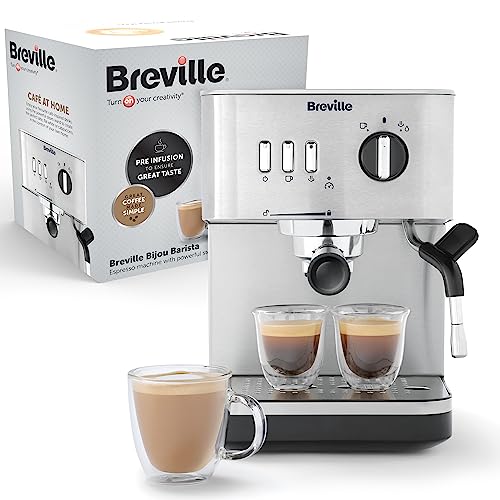Why Nobody Cares About Commercial Espresso Machine

What to Look For in a Commercial Espresso Machine
There are a number of factors to consider when purchasing a commercial espresso machine. The type of espresso machine ideal for your establishment will be determined by the quantity of use, the purpose, and the barista's skill.
A double boiler system allows you to steam while brewing. This cuts down on the time to recover between pulls. Proportional-integral-derivative (PID) temperature control manages on/off cycles for optimal boiler temperatures.
Productivity

A commercial espresso machine is designed to handle a larger amount of coffee than a home espresso machine. If you expect a home espresso maker to work in a professional environment would be the recipe for disaster.
A commercial machine of the highest quality can serve up to 100 cups of coffee per hour at peak times. This is a huge benefit for busy workplaces, preventing employees from having to sit around while waiting to get their coffee.
A coffee maker can help workers bond. Teams of workers often are able to take turns ordering coffee for each other, which can facilitate collaboration and teamwork within the workplace. A dedicated space to enjoy coffee can aid new employees in feeling at comfortably in the workplace, breaking down any barriers between them and senior staff members.
Commercial espresso machines are available in a variety of sizes to accommodate different requirements. Certain models are fully automated and others are able to pre-program espresso shot sizes so that the operators don't have to guess the correct size. This is especially crucial for businesses with inexperienced baristas, since inaccurate shots can drastically affect the flavor and intensity of espresso brewed. In addition, it is recommended to purchase ethically sourced and manufactured commercial espresso machines that support the communities in which coffee is grown. This will ensure a high quality product that will minimize the negative impact on the environment.
Safety
Espresso machines are massive machines that weigh a lot that can cost more than a brand new compact car. The machines are designed to make hundreds of drinks and shots in one day. Commercial espresso machines pose particular health and safety risks to employees because of their sheer volume.
Remember that commercial espresso machines are more likely to utilize warm water. This can trigger the growth of bacteria. Poorly maintained machines that are not descaled and cleaned regularly can accumulate spent espresso. This could cause it to turn rancid, and potentially cause illness when consumed by customers. A commercial espresso machine that has a a steam wand that is not sealed may allow bacteria to flourish in the milk that is frothing.
Think about the kind of beverage you will serve and how many cups an hour your space can handle when choosing a commercial coffee maker. You'll also want an espresso machine with automated features, which makes it simpler and quicker to serve your customers your favorite coffee drink. Find a warranty that includes both parts and labor. This will guarantee that any technical issues will be solved quickly.
Energy Efficiency
The power requirements for commercial espresso machines are considerably more powerful than those used in home settings. Professional espresso machines are more heavy and have larger capacity boilers in order to support multiple group heads for standard cafe production. They also operate at a much greater temperature at ambient temperatures and are often located in an indoor space (such as a restaurant or coffee shop) where the electronic components can quickly overheat, resulting in malfunctioning machines.
The boiler of a commercial espresso machine is heated and holds the pressurized water, which is supplied by an electric pump. This water is then used to brew and steaming espresso. The boiler is comprised of a number of copper tubes that are heated by electric elements. When the brew level sensor detects that the water has reached its desired level the solenoid valve will open to fill the boiler with fresh water, and the heating element is shut off.
There are four types of espresso machines. They differ by their ability to brew or steam by using the TB (brewing-only), TX (twin-boilers) HX (double automated), and DA (double automated). TB and TX machines have stable brew temperatures, while DA can provide rapid steaming using a single boiler. Many cafes are converting to HX machines, since they have been shown to provide the best of both worlds in terms steam and brew temperatures.
Maintenance
Commercial espresso machines need regular maintenance similar to cars. They need to be maintained in order to run smoothly and efficiently. If you make the effort to keep your machine in good condition, it will provide you a better tasting espresso and last longer.
Cleaning your espresso machine is a regular practice, but it's crucial to clean certain components on a deeper level. There will be residues from coffee grounds and other milk products that can cause the machine to fail over time. Regular cleaning will keep your espresso machine in great condition.
The majority of commercial espresso machines require descaling every three months. This process requires more steps than normal cleaning, and you'll need to read the manual to ensure that you're adhering to the directions. Descaling involves using a solution to dissolves the scale in the water tank. In order to complete this process you'll need a container under the steam wand and in some models, beneath the coffee spouts. Follow the directions for your specific model.
Another maintenance step includes changing the water filters. It's easy to overlook, but it is important to avoid accumulating mineral deposits. Be sure to look for calcification, which is difficult to get rid of, in the spray head.
